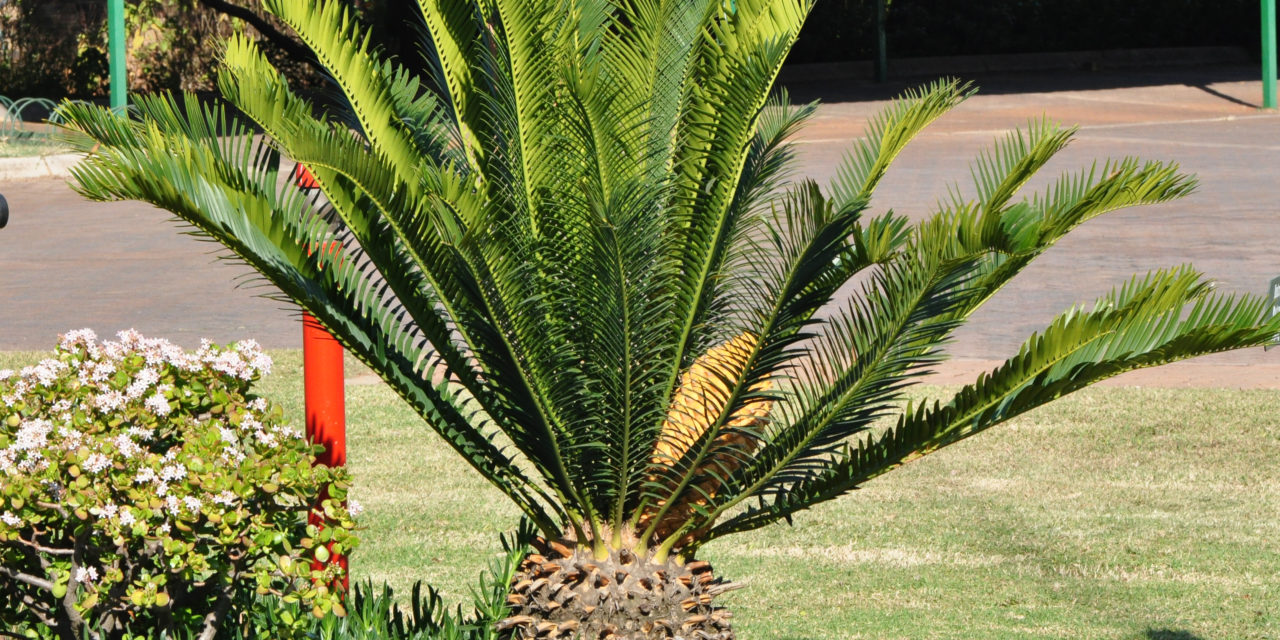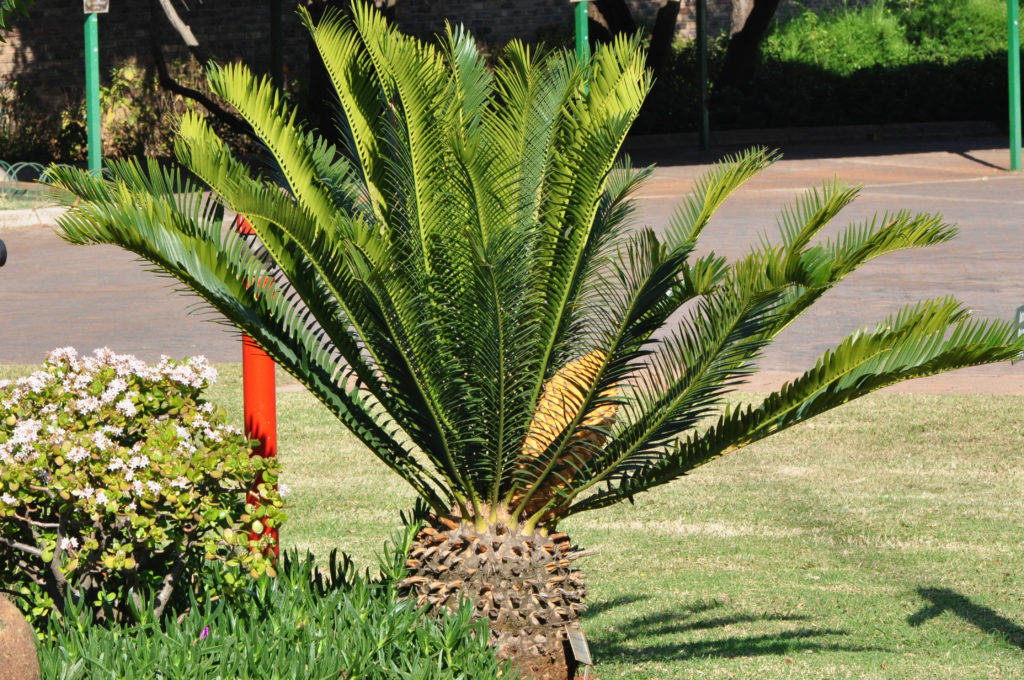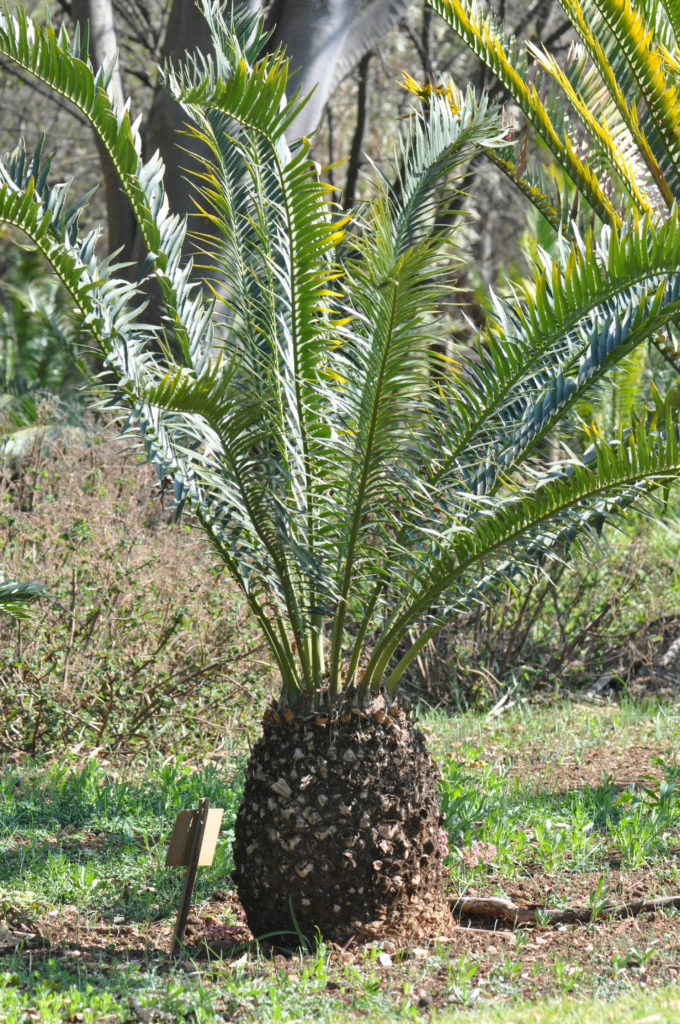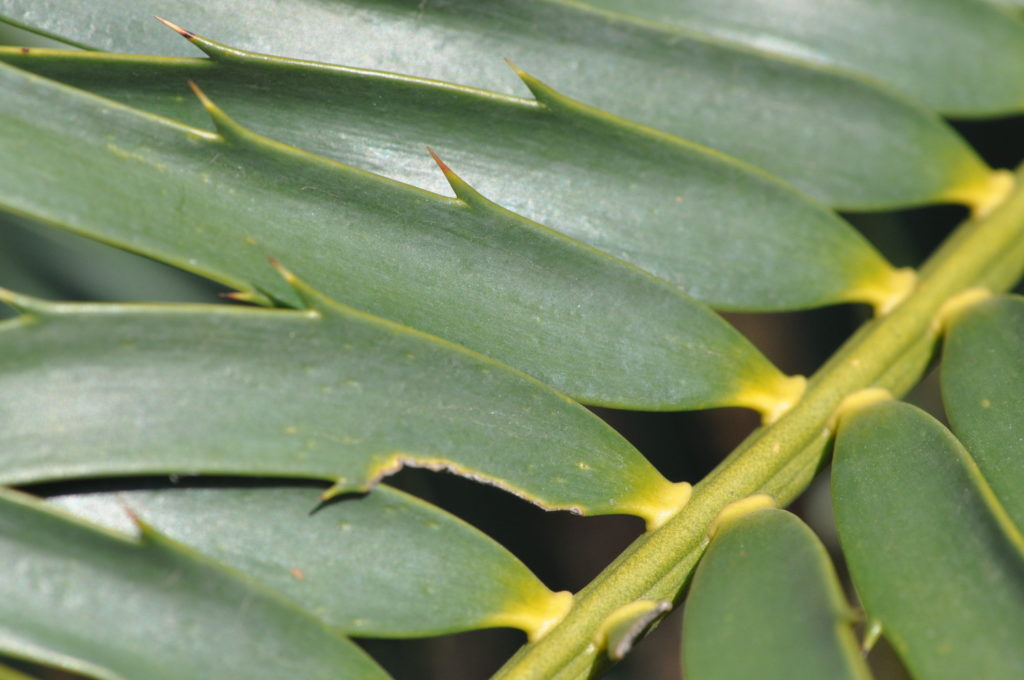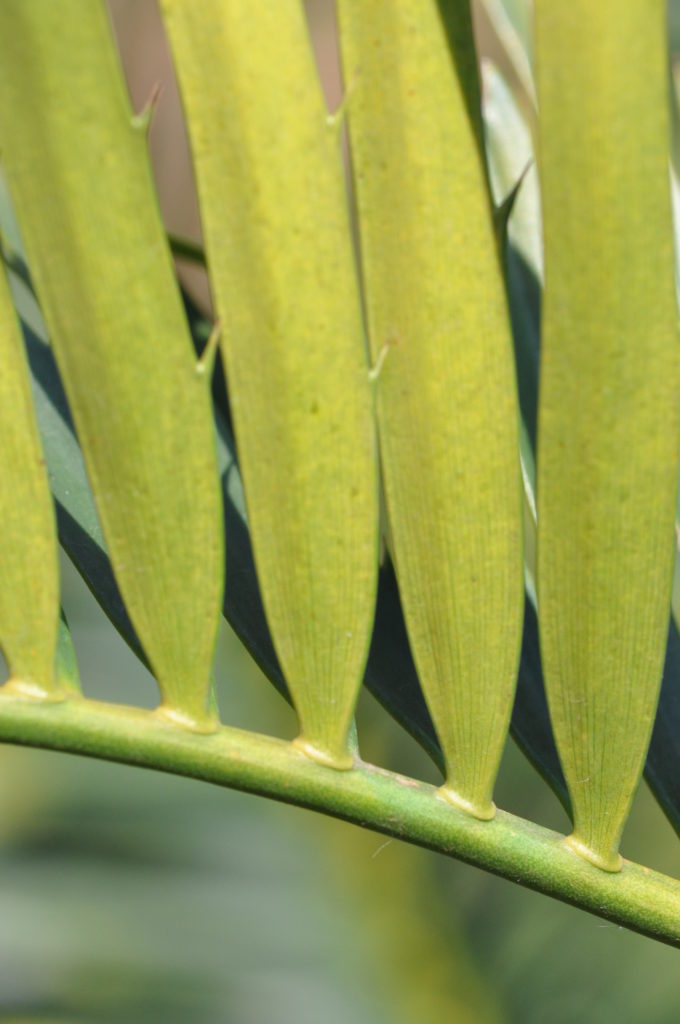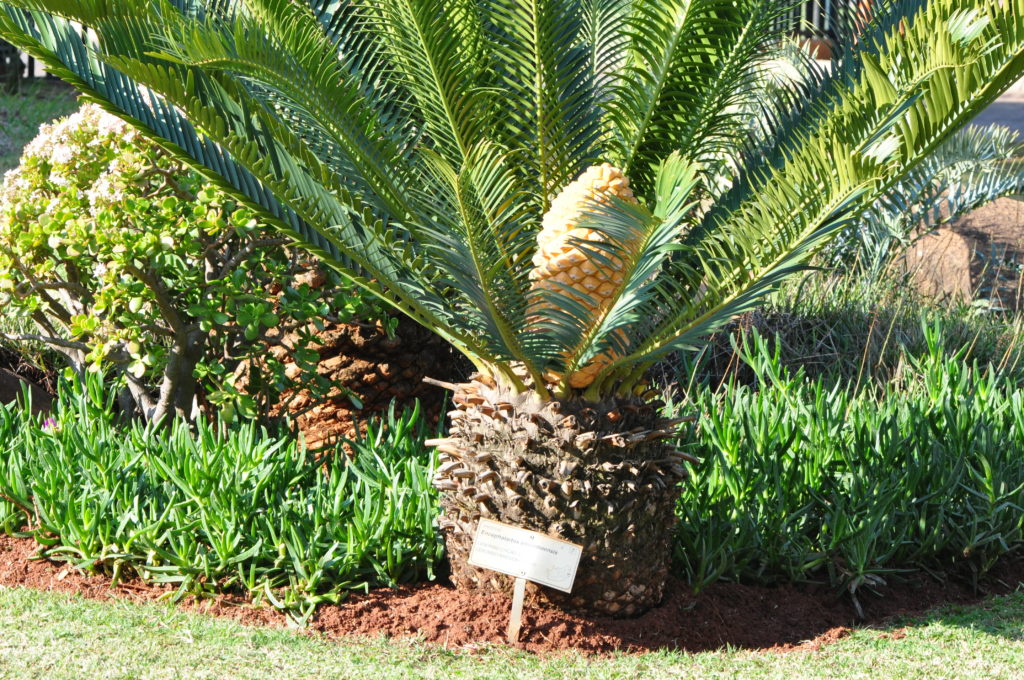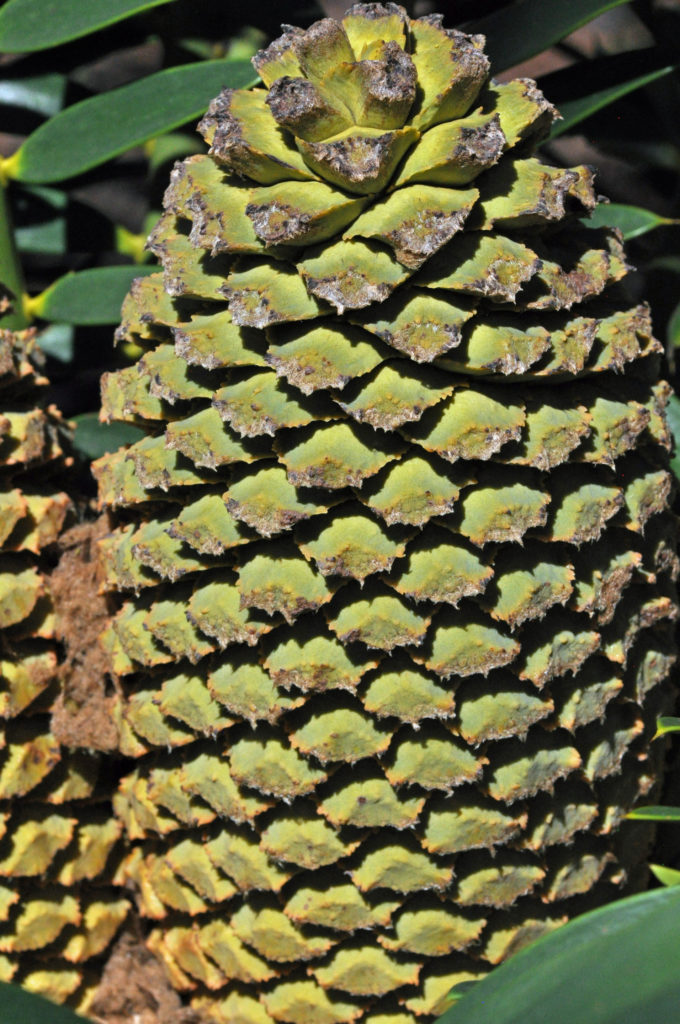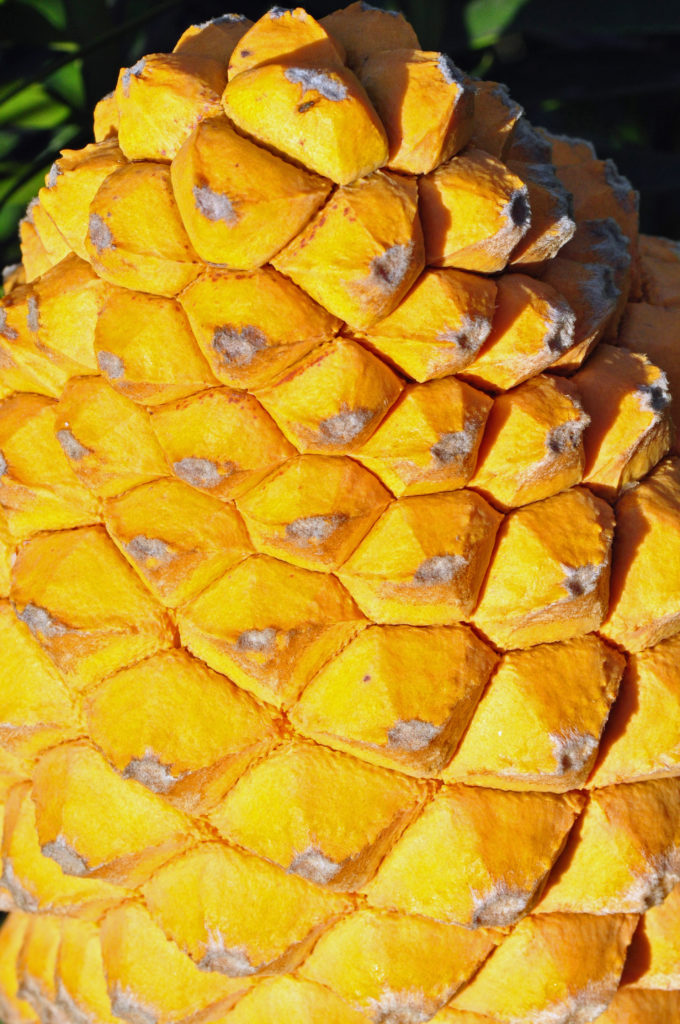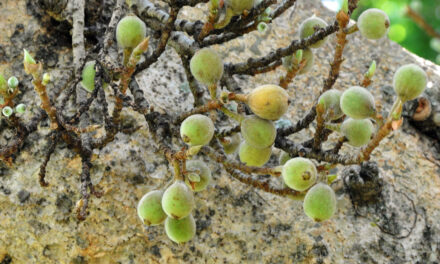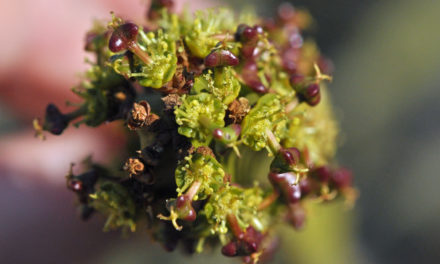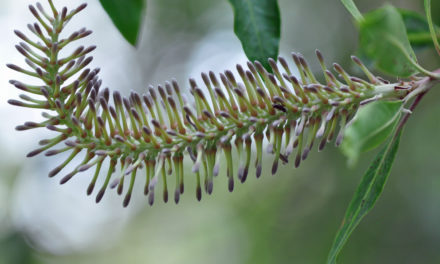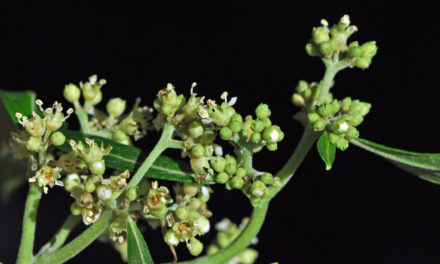General Info – summary
This endemic, dioecious, usually vertical Tree is up to 4m high, 30cm in diameter and may have more than one stem. Pinnately compound Leaves are up to 2m long and leaflets may be sickle shaped, have prickles on both sides and are reduced to spines at the leaf base. Up to 2 male and 3 female Cones may develop. Male cones produce motile sperm and beetles are pollinators. Poisonous Seeds are glossy red.
Description
Encephalartos lebomboensis
SA Tree No. 14.8.
Common names: (Afr) Broodboom, Lebombo broodboom, Piet Retief broodboom. (Eng) Piet Retief Cycad, Lebombo Cycad. (isiZulu) Isigqiki-somkhova. (siSwati) Ligebeleweni, Sijekwane. Isigqiki-somkhova applies generally to cycad species with trunks.
Family: Zamiaceae. This family is part of the major group: Gymnosperms. Zamiaceae are usually cone-bearing plants producing naked seeds and include Ginkgo (in China), Cycads, Conifers (e.g., pine trees) and Gnetophytes: e.g., the unique Welwitschia mirabilis (tweeblaarkanniedood) are not wind pollinated and found in the deserts of western Namibia and southern Angola. Members of the gymnosperm family Zamiaceae have no flowers or fruit and the seeds are often contained in Cones. This family has 8 genera, including the Genus Encephalartos, which contains all species of cycads.
Name derivation: Encephalartos – within-head-bread: referring to the starchy bread that can be made from the pith of the inner trunk. lebomboensis – grows in the Lebombo Mountains (from Hluhluwe – in the south of KwaZulu-Natal, through Mpumalanga to Punda Maria in the Limpopo Province in the north. Part of the mountains also occur in Mozambique and Swaziland). In 1949, Inez Clare Verdoorn (1896-1989) made the first description of this plant. She was a South African taxonomist and botanist who eventually was in charge of the herbarium in Pretoria. The genus Encephalartos includes some of the most primitive living Gymnosperms. Many of the cycads originally classified as E. lebomboensis are now regarded as E. senticosus. The African plants in the genus Encephalartos include about 66 species and 35+ species occur in southern Africa.
Conservation Status: E N. (Endangered). Assessment Date: 2009.10.31 (J.S. Donaldson). The population trend is decreasing. This is mainly due to illegal collection for personal gain, and for its use in traditional medicine. Depending on who identifies the plant, the status may become critically endangered.
Tree
This Tree may reach 3-5m high and the Trunk is usually vertical or reclining. Species of Encephalartos (Cycads) are only superficially palm or fern like and are usually unbranched (intro photo & photo 2) and up to 30cm in diameter. The trunk has a large pith. This tree may sucker from the base, producing up to 8 stems. The crown may become quite woolly at coning time. The cycad tap Root is usually soon replaced by lateral roots, which become woody. Cycads have Coralloid Roots that contain symbiotic cyanobacteria (blue-green algae) that fix atmospheric nitrogen. Through a process of complex biological pathways, the cyanobacteria convert atmospheric molecular nitrogen into compounds such as ammonia, and amino acids needed by the cycads.
- Photo 1: David Becking.
- Photo 2: David Becking.
Leaves
Leaves are up to 2m x 27cm, and form a dense crown at the end of the trunk. They are straight or slightly recurved near the end (intro photo). Eventually only leaf scars remain on the trunk once the leaves fall. Young leaves are hairy but mature leaves are hairless and may remain on the trees for more than a year. Unlike other members of the family Zamiaceae, the Encephalartos species (cycads) have Leaflets that lack a central Midrib (vein). The hard leaflets do not bend easily. Cycads are unique Gymnosperms having pinnately compound leaves with leaflets arranged along either side of the leaf Rachis (here the main axis of a compound structure bearing leaflets). The leaflet arrangement on the rachis resemble a feather (photo 2 – under Tree). The closely spaced Leaflets have parallel veins that are more visible on the lower side (photo 4). Petiolules (stalks of leaflets) are absent. Leaflets overlap downwards (photo 3). Individual leaflets may be sickle shaped. They are glossy, mid to dark green above (photo 3) and lighter below (photo 4). Each leaflet measures up to 17 x 2,2cm. They usually have up to 4 prickles on both Margins (photo 3). Leaflets near the leaf bases become more and more reduced to spines. Stomata (structure utilising 2 guard cells that, unlike lenticels, can control gaseous exchange) are present on the leaflets.
- Photo 3: David Becking.
- Photo 4: David Becking.
Cones
Like most gymnosperms, the cycads produce cones not flowers. This tree is Dioecious (having male and female cones on separate plants) and the sex of the tree is difficult to determine until the cones appear. The Cones develop in the centre of the leaf whorls. There are usually 1 or 2 stalkless Male Cones that are thin, narrowly cylindrical and yellowish-green. Each cone is up to 45 x 14cm. Pollen is contained in dense packets on the lower surface of the cone scales. The visible upper surface of scales on the male cone is raised and slightly flat. Initially up to 3 green, sessile Female Cones open to receive pollen (photo 6). These cones close and mature to bright yellow or slightly pink and up to 45 x 30cm (photo 7). Each obovate (egg-shaped) cone bares 2 naked ovules on the upper surface of each scale. The tree is insect pollinated, and Beetles (Coleoptera) have been identified as the most common pollinators of the southern African cycads. The shiny, scarlet Seeds are smooth, glossy red and about 4 x 2,2cm. At maturity, seeds are released when the Female cones disintegrate. Monkeys and baboons disperse the seeds.
Gymnosperms have unenclosed or naked seeds. They lack both flowers and fruit and the seeds are often contained in cones. In the Angiosperms (flowering plants), the seeds are enclosed in an ovary. In the Gymnosperms there are 2 modes of fertilization. In all the Cycads (including Encephalartos) and the single extant (not extinct) Ginkgo biloba (China), the male cones produce motile sperms. The remaining members of the Gymnosperms all have non-motile sperm with no flagella and a Pollen tube moves the sperm to the egg.
- Photo 5: David Becking.
- Photo 6: David Becking.
- Photo 7: David Becking.
Distribution & Ecology
This cycad is Endemic (restricted to a particular geographic location) in southern Africa. Encephalartos lebomboensis plants are found in Paulpietersburg in northern KwaZulu-Natal and in Piet Retief in Mpumalanga. Outside South Africa, they occur in north east as well as southern Swaziland and southern Mozambique. These trees grow on rocky slopes and cliffs e.g., the Lebombo Mountains in Mpumalanga (running through Piet Retief – slightly west of southern Swaziland). Due to climatic changes, small and large leaf bases may be visible, resulting in different sized patterns of leaf scars that are left when the leaves fall. Like annual rings, these remains help provide a history of recent climate fluctuations. The tree is resistant to fire and drought.
Ethnobotany
These trees may be becoming extinct in the wild. They grow in full sunlight in a misty environment with hot wet summers. Small and large leaf bases, due to climatic changes, may result in patchwork patterns of leaf scars left when the leaves fall. Like annual rings, these remains may help provide a history of climate fluctuations. Trees are semi-hardy to frost and are a popular plant in households. They can be grown from suckers or seeds and have the ability to transplant readily. They require good drainage and do best on a slope.
References
Boon, R. 2010. Pooley’s Trees of eastern South Africa. Flora and Fauna Publications Trust, Durban.
Coates Palgrave, M. 2002. Keith Coates Palgrave Trees of Southern Africa, edn 3. Struik, Cape Town.
Donaldson, J.S. 2009. Encephalartos lebomboensis I.Verd. National Assessment: Red List of South African Plants version 2020.1. Accessed on 2023/04/11.
Lawrence, G. H. M, 1951. Taxonomy of Vascular Plants, The Macmillan Company, New York. Tenth Printing 1965.
Palmer, E. & Pitman, N. 1972. Trees of southern Africa, Balkema, Amsterdam, Cape Town.
Schmidt, S. Lotter, M. & McCleland, W. 2002. Trees and Shrubs of Mpumalanga and the Kruger National Park.
http://www.plantzafrica.com/plantefg/encephlebomb.htm
https://en.wikipedia.org/wiki/Encephalartos_lebomboensis
http://cycadsociety.org/?page_id=1806
http://pza.sanbi.org/encephalartos-lebomboensis
https://www.revolvy.com/topic/Encephalartos%20lebomboensis
http://biodiversityadvisor.sanbi.org/wp-content/uploads/sanbi-identify-it/plants/encephalartos.htm
http://www.theplantlist.org/browse/G/Zamiaceae/
https://www.diffen.com/difference/Angiosperms_vs_Gymnosperms
https://en.wikipedia.org/wiki/Inez_Clare_Verdoorn
Insect pollination in the African cycad Encephalartos friderici-guilielmi Lehm – ScienceDirect

